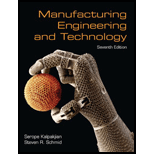
Concept explainers
Explain why continuous chips are not necessarily desirable.
Explain why continuous chips are not necessarily desirable.
Explanation of Solution
In computer-controlled machine tools, continuous chips are not preferred. This is because they can get tangled around the tool holder, fixture or even the workpiece. It can also get tangled into the chip disposal system. To clear these chips, it is possible that the operation may be needed to halted.
This problem can be resolved if we use chip breakers. The cutting speed can be changed, or the feed, depth of cut can be varied. It can also be solved by using cutting fluids.
Want to see more full solutions like this?
Chapter 21 Solutions
Manufacturing Engineering & Technology
Additional Engineering Textbook Solutions
Automotive Technology: Principles, Diagnosis, And Service (6th Edition) (halderman Automotive Series)
HEAT+MASS TRANSFER:FUND.+APPL.
Statics and Mechanics of Materials (5th Edition)
Mechanics of Materials, 7th Edition
Heating Ventilating and Air Conditioning: Analysis and Design
Heat and Mass Transfer: Fundamentals and Applications
- What is the mechanism material removal in EDM? Explain in detail.arrow_forwardWhat are the functions served by cutting fluid? Give broad classification of cutting fluid and explain each in detail .arrow_forwardDraw the forces and angles involved in the cutting process and calculate shear angle (0), friction coefficient and tangential force if ,cutting force = 80 kN, resultant of forces =100kN, friction force=75kN, rake angle =20° undeformed chip thickness = 0.65mm and deformed chip thickness = 0.72mmarrow_forward
- A flat milling operation will be carried out with a horizontal milling machine, in a piece of 250 mm in length and 50 mm in width, using a felicoidal bur with a diameter of 75 mm, with 10 teeth. If the feed per tooth is 0.2mm, and the cutting speed is 0.75 m / s, how would you determine the speed of metal removal to remove 6 mm from the surface of this piece?arrow_forwardWhat is difference in turning and boring processes? Explain the difference if any in the equations for cutting speed, material removal rate, and machining timearrow_forwardManufacturing Processes What is the effect of shear plane angle in metal cutting? Illustrate with diagramarrow_forward
- Explain the mechanics of metal cutting with neat sketch. Why machining of ductile and brittle material leads to form continuous and discontinuous chip respectively?arrow_forwardWhat is dielectric? Discuss the impact of dielectric properties on machining characteristics in EDM.arrow_forward21.12 What is the function of chip breakers? How do they function? Do you need a chip breaker to eliminate continuous chips in oblique cutting? Explain.arrow_forward
- Figure 9 shows the effect of rotary speed on the material removal rate by using conventional EDM and ultrasonic-assisted EDM. Discuss on the effect of rotary speed on the material removal rate for both EDM processes.arrow_forwardIdentify some of the reasons why machining is commercially and technologically important.arrow_forwardIf you could perhaps offer a definition as well as an explanation of the idea of "expandability" in relation to picking devices that are near to one another.arrow_forward
 Elements Of ElectromagneticsMechanical EngineeringISBN:9780190698614Author:Sadiku, Matthew N. O.Publisher:Oxford University Press
Elements Of ElectromagneticsMechanical EngineeringISBN:9780190698614Author:Sadiku, Matthew N. O.Publisher:Oxford University Press Mechanics of Materials (10th Edition)Mechanical EngineeringISBN:9780134319650Author:Russell C. HibbelerPublisher:PEARSON
Mechanics of Materials (10th Edition)Mechanical EngineeringISBN:9780134319650Author:Russell C. HibbelerPublisher:PEARSON Thermodynamics: An Engineering ApproachMechanical EngineeringISBN:9781259822674Author:Yunus A. Cengel Dr., Michael A. BolesPublisher:McGraw-Hill Education
Thermodynamics: An Engineering ApproachMechanical EngineeringISBN:9781259822674Author:Yunus A. Cengel Dr., Michael A. BolesPublisher:McGraw-Hill Education Control Systems EngineeringMechanical EngineeringISBN:9781118170519Author:Norman S. NisePublisher:WILEY
Control Systems EngineeringMechanical EngineeringISBN:9781118170519Author:Norman S. NisePublisher:WILEY Mechanics of Materials (MindTap Course List)Mechanical EngineeringISBN:9781337093347Author:Barry J. Goodno, James M. GerePublisher:Cengage Learning
Mechanics of Materials (MindTap Course List)Mechanical EngineeringISBN:9781337093347Author:Barry J. Goodno, James M. GerePublisher:Cengage Learning Engineering Mechanics: StaticsMechanical EngineeringISBN:9781118807330Author:James L. Meriam, L. G. Kraige, J. N. BoltonPublisher:WILEY
Engineering Mechanics: StaticsMechanical EngineeringISBN:9781118807330Author:James L. Meriam, L. G. Kraige, J. N. BoltonPublisher:WILEY





